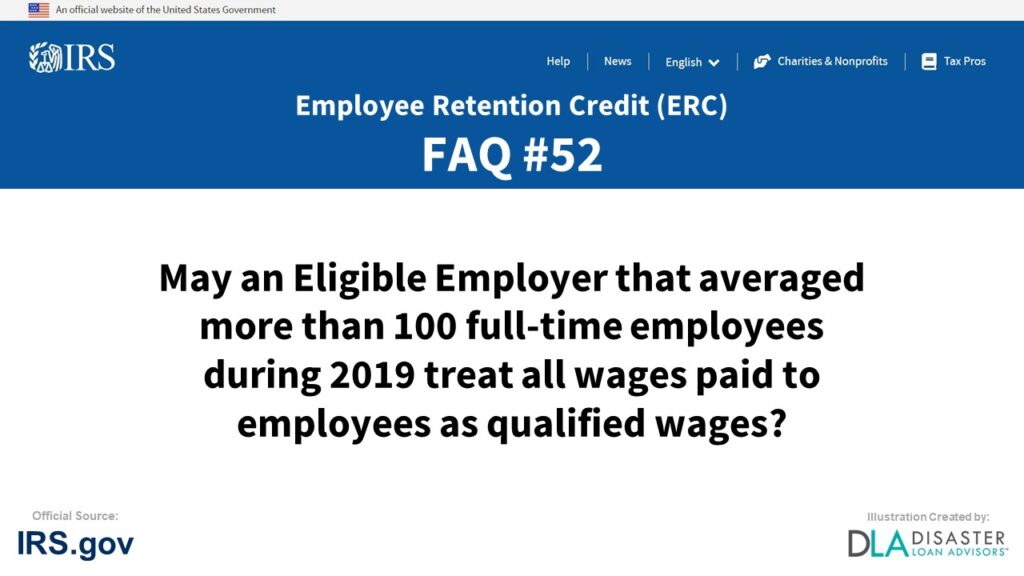
Frequently asked question #52 “May an Eligible Employer that averaged more than 100 full-time employees during 2019 treat all wages paid to employees as qualified wages?” under the Determining Qualified Wages section of FAQs: Employee Retention Credit under the CARES Act, provided by the IRS.gov to help business owners understand the ERC program. Information is below for the question #52 May an Eligible Employer that averaged more than 100 full-time employees during 2019 treat all wages paid to employees as qualified wages?
ERC Credit Frequently Asked Question #52:
COVID-19-Related Employee Retention Credits:
Determining Qualified Wages FAQs
52. May an Eligible Employer that averaged more than 100 full-time employees during 2019 treat all wages paid to employees as qualified wages?
No. Eligible Employers that averaged more than 100 full-time employees for 2019 may not treat the wages paid to employees for the time that they provide services to the employer as qualified wages.
For these employers, only wages paid to employees, after March 12, 2020, and before January 1, 2021, for the time they are not providing services during a calendar quarter in which the employer’s business operations are fully or partially suspended due to a governmental order or in which the employer experiences a significant decline in gross receipts may be treated as qualified wages.
Example 1: Employer Q, a local chain of full service restaurants in State X that averaged more than 100 full-time employees in 2019, is subject to a governmental order for restaurants to discontinue sit-down service to customers inside the restaurant, but may continue food or beverage sales to the public on a carry-out, drive-through, or delivery basis
Employer Q continues to pay wages to kitchen staff and certain wait staff needed to facilitate fulfillment of carry-out orders. Wages paid to these employees for the time that they provide carry-out service are not qualified wages.
Example 2: Employer R averaged more than 100 full-time employees in 2019 and was forced to suspend operations at the end of the first calendar quarter in 2020. Its employees performed services during the first part of the calendar quarter but then stopped due to the suspension of operations; however, Employer R continued to pay the employees’ normal wages for the entire quarter, including the period during which they were not providing services.
The wages paid during the period when employees were not providing services are qualified wages.
For more Internal Revenue Service (IRS) Department of the Treasury Employee Retention Credit (ERC) Determining Qualified Wages FAQs, visit the official IRS.gov tax website.
Conclusion and Summary on ERC Credit FAQ #52. May an Eligible Employer that averaged more than 100 full-time employees during 2019 treat all wages paid to employees as qualified wages?
The “May an Eligible Employer that averaged more than 100 full-time employees during 2019 treat all wages paid to employees as qualified wages?” is Frequently Asked Question #52 of many commonly asked questions small business owners are wondering about how to file the Employee Retention Tax Credit (ERTC). The IRS ERC Tax Credit program is a confusing and complex process to determine the correct ERC calculations your business qualifies for. Answers to “May an Eligible Employer that averaged more than 100 full-time employees during 2019 treat all wages paid to employees as qualified wages?” and filling out form 941-X may change slightly from frequently updated rules and regulations from the IRS. Leave a comment below if you have further questions on ERC Credit FAQ #52.
Help Completing / Filing / Claiming the Employee Retention Credit (ERC)
Receive Up to a $26,000 ERC Credit from the IRS Per Employee
Disaster Loan Advisors can assist your business with the complex and confusing Employee Retention Credit (ERC), Form 941-X, and the Employee Retention Tax Credit (ERTC) program.
Depending on eligibility, business owners and companies can receive up to $26,000 per employee based on the number of W2 employees you had on the payroll in 2020 and 2021.
The ERC / ERTC Tax Credit Program is a valuable IRS tax credit you can claim. This is money you have already paid to the IRS in payroll taxes for your W2 employees.
We DO NOT charge a percentage (%) of your ERC Refund like some companies are charging. Some ERC firms out there are charging upwards of 15% to 35% of your ERC refund!
Our professional ERC fee and pricing structure is very reasonable in comparison.
If you are looking for an ERC Company that believes in providing professional ERC Services and value, in exchange for a fair, reasonable, and ethical fee for the amount of work required, Disaster Loan Advisors is a good fit for you.
Schedule Your Free Employee Retention Credit Consultation to see what amount of employee retention tax credit your company qualifies for.
Cover Image Credit: Irs.gov / ERC FAQ / Disaster Loan Advisors
